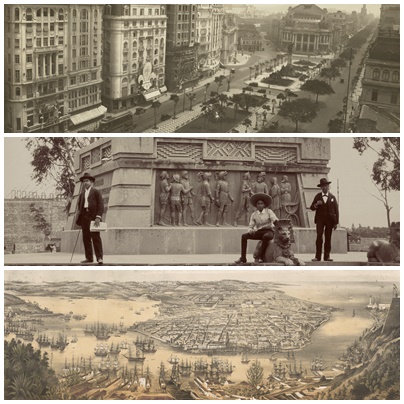"La metrópolis en América Latina, 1830-1930"
Idurre Alonso y Maristella Casciato | Curators
This exhibition has been organized by the Getty Research Institute, Los Angeles, and was previously on view as part of Pacific Standard Time: LA/LA.

Museo Amparo, Puebla, Mexico
Av 2 Sur 708, Centro, 72000 Puebla, Pue., Messico+52 222 229 3850 email :
Jul 28 > Nov 12,2018
 |
Sociopolitical upheavals and cultural transitions reshaped the architectural landscapes of major cities in Latin America during a century of rapid urban growth. Radical breaks with the colonial past, transformative architectural exchanges with Europe and beyond, and the subsequent reinterpretation of pre-Hispanic, Spanish, and Portuguese motifs influenced the emergence of a modernist culture and a modern architectural idiom.
This exhibition presents the colonial city as the urban model imposed by the Iberian powers, and the new republican city as a transfer of sources and technical knowledge that were eventually appropriated, interpreted, and later subverted through a wave of revivals. Following this narrative, The Metropolis in Latin America, 1830-1930, reveals how six capitals—Buenos Aires, Havana, Lima, Mexico City, Rio de Janeiro, and Santiago de Chile—were transformed from colonial cities into monumental republican metropolises. Photographs, prints, plans, and maps depict the urban impact of key socioeconomic changes, including the emergence of a bourgeois elite, extensive infrastructure projects, and rapid industrialization and commercialization.
This exhibition presents the colonial city as the urban model imposed by the Iberian powers, and the new republican city as a transfer of sources and technical knowledge that were eventually appropriated, interpreted, and later subverted through a wave of revivals. Following this narrative, The Metropolis in Latin America, 1830-1930, reveals how six capitals—Buenos Aires, Havana, Lima, Mexico City, Rio de Janeiro, and Santiago de Chile—were transformed from colonial cities into monumental republican metropolises. Photographs, prints, plans, and maps depict the urban impact of key socioeconomic changes, including the emergence of a bourgeois elite, extensive infrastructure projects, and rapid industrialization and commercialization.
mpefm
MEXICO art press release
Galerías 1 y 2
Museum Hours :
Monday 10 a.m. - 6 p.m.
Tuesday Closed
Wednesday 10 a.m. - 6 p.m.
Thursday 10 a.m. - 6 p.m.
Friday 10 a.m. - 6 p.m.
Saturday 10 a.m. - 9 p.m.
Sunday 10 a.m. - 6 p.m.
Admission
Wednesday to Saturday
$35.00 MXN Adults
$25.00 MXN Students / Teachers with ID
Sundays and Mondays
Free admission
Wednesday to Saturday
Free admission for:
People with Pasaporte Cultural
Seniors (with INSEN / INAPAM)
Children under 12
ICOM and ICOMOS Members
Red de Arte Contemporáneo (RAC) Card
Family Pass (for Museo Amparo\'s employees)
Museum Hours :
Monday 10 a.m. - 6 p.m.
Tuesday Closed
Wednesday 10 a.m. - 6 p.m.
Thursday 10 a.m. - 6 p.m.
Friday 10 a.m. - 6 p.m.
Saturday 10 a.m. - 9 p.m.
Sunday 10 a.m. - 6 p.m.
Admission
Wednesday to Saturday
$35.00 MXN Adults
$25.00 MXN Students / Teachers with ID
Sundays and Mondays
Free admission
Wednesday to Saturday
Free admission for:
People with Pasaporte Cultural
Seniors (with INSEN / INAPAM)
Children under 12
ICOM and ICOMOS Members
Red de Arte Contemporáneo (RAC) Card
Family Pass (for Museo Amparo\'s employees)
QR of this press release
in your phone, tablet








